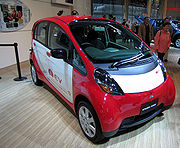
Mitsubishi Australia CEO and President , Robert McEniry is just introduced the
i MiEV electric car at the Boathouse Restaurant in Canberra. He claimed this was the world's first production electric car and had now been prepared for sale in Australia (not just a handmade prototype). Mr. McEniry did not shy away from the fact that because Australian electricity is generated from polluting coal.
Dr. Peter Pudney from University of South Australia is then going to talk about the issues with electric cars. A little later we get to drive the car I have already driven a hand made
Australian made electric car. The i MiEV is an electric version of the
Mitsubishi i "K class" small car.
The 88 batteries for the car are
lithium ion. One issue is the life of the batteries. The
Nickel-metal hydride batteries in the
Toyota Prius have lasted well.
The i MiEV is a very compact four seat car. Unlike most small cars, the engine is under the back seat, driving the rear wheels. The electric version has the batteries and electric motor in place of the fuel tank and petrol engine. The car has some addition CAM bus ecus to control the electric motor, with redundancy for reliability.
It struck me that the i MiEV has a similar layout to the
Tata Nano. India already makes the
REVA Electric Car. Assuming that Tata can meet demand for their petrol version, an electric Nano would seem a logical future development.
However, the major competitor for the i MiEV are inexpensive conventionally powered cars. To make such cars viable there will need to be sufficient renewable energy available and a sophisticated greenhouse gas policy to give incentives for its use. What also may help is a computer controlled
smart grid to optimise the charging the cars. Smart transport systems would help optimise the use of the cars.
One example would be to use the cars with a share program such as that from
GoGet. The share cars are parked at reserved parking spaces in the inner suburbs. It would make sense to equip these parking spaces with recharging stations. This would maximise the use of the cars.
There were staff of both the federal environment and innovation departments at the briefing. Hopefully they are not considering giving Mitsubishi a subsidy for the car in Australia. There are a lot better ways Australia could spend its money in the national economic and environmental interests.
Labels: electric car, Mitsubishi iMiEV, sustainable development
 Mitsubishi Motors is showing its i-MiEV CARGO electric van at the 41st Tokyo Motor Show. This is derived from the i-MiEV electric car, which I test drove in Canberra. It will be on sale in Japan from April 2010.
Mitsubishi Motors is showing its i-MiEV CARGO electric van at the 41st Tokyo Motor Show. This is derived from the i-MiEV electric car, which I test drove in Canberra. It will be on sale in Japan from April 2010. Also on show will be the PX-MiEV hybrid petrol/electric "crossover" concept car. This appears to be Mitsubishi's answer to the Toyota Kluger Hybrid. Such a vehicle makes no practical sense and hopefully this one will not go into production.
Also on show will be the PX-MiEV hybrid petrol/electric "crossover" concept car. This appears to be Mitsubishi's answer to the Toyota Kluger Hybrid. Such a vehicle makes no practical sense and hopefully this one will not go into production.

